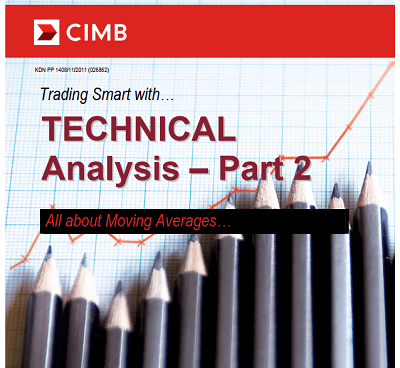All about Moving Average- Trading smart with Technical Analysis provides a detailed overview of Moving Averages (MAs) in technical analysis.
- Introduction to Moving Averages (Page 3): MAs are trend-following indicators that smooth price data over a specified period to identify the main trend. They lag because they rely on past prices but help filter market noise.
- Why the Lag? (Page 3): The lag is inherent due to using historical data, but this helps confirm trends rather than predict them. Many indicators like MACD and Bollinger Bands are MA-based.
- Types of MAs (Page 4): The two main types are Simple Moving Averages (SMAs) and Exponential Moving Averages (EMAs). SMAs average prices equally, while EMAs give more weight to recent prices, reducing lag. Neither is inherently better; EMAs react faster, while SMAs are better for identifying support/resistance.
- Popular MAs (Page 5): Common SMAs include:
- 200-day SMA for long-term trends (>6 months).
- 50-day SMA for medium-term trends (1-3 months).
- 20-day SMA for short-term trends (1-3 weeks).
- Intraday traders use 5, 15, 30, and 60-minute SMAs for very short-term trends.
- Example: The 200-day SMA on the Dow Jones Industrial Index (DJIA) is a long-term trend indicator, but the 150-day SMA better captured major turning points, showing the need to back-test for each stock/index.
- Case Studies (Page 6):
- Citibank (2007-2009): The 200-day SMA acted as a major resistance, preventing upward moves until mid-2009. Investors using it avoided the 2007-2008 collapse.
- More Examples (Page 7):
- Hang Seng Index (2009-2010): The 50-day SMA was a good medium-term trend and support indicator, but it lost effectiveness in sideways markets from late 2010.
- Google: Comparing 20-day and 30-day SMAs, the 30-day SMA provided better support with fewer false signals, emphasizing the importance of back-testing.
- How to Use MAs (Page 9): MAs confirm trends, not predict them. Example: Crude oil’s price crossing below the 200-day SMA signaled the end of a long-term uptrend and the start of a downtrend.
- Commodities Example (Page 10):
- Crude Palm Oil (CPO, 2007-2008): The 50-day SMA supported prices in 2007, but a break below it in 3Q 2008 confirmed a medium-term downtrend.
- Additional Strategies (Page 2): The document mentions strategies like single, double, and triple crossovers, Moving Average Price Channels (MAPC), Moving Average Compression (MAC), and MACD, though details are not provided in the given pages.
The document stresses the importance of back-testing MAs for specific stocks or indices and highlights their role in identifying trends and support/resistance, despite their lagging nature.
Contents
Introduction to moving averages ………………………………………………………3
What is a moving average?…………………………………………………………………………3
Why the lag?…………………………………………………………………………………………….3
Popular moving averages …………………………………………………………………………..4
Popular moving averages……………………………………………………………………5
One of the oldest and reliable indicators……………………………………………………….5
How to use moving averages …………………………………………………………….9
Strategies using moving averages…………………………………………………..17
Single crossover ………………………………………………………………………………..18
Double crossover……………………………………………………………………………….20
Triple crossover…………………………………………………………………………………23
Moving average price channel (MAPC)……………………………………………25
Moving average compression (MAC)……………………………………………….30
MACD …………………………………………………………………………………………………..36
Putting it all together………………………………………………………………………..44
Excerpts
Introduction to moving averages
The trend is your friend
What is a moving average?
A moving average (MA) is basically an average value of data over a specified time period. An MA smooths the price
data to form a trend-following indicator. MAs do not predict price direction but define the current direction though
with a lag.
Why the lag?
MAs lag simply because they are based on past prices. However, this is not a bad thing as they filter out the
“noise” in the market and only identify the main trend. Furthermore, many popular technical indicators like
MACD and Bollinger Bands are based on MAs.
Popular moving averages
The two most popular types of MAs are the simple moving average (SMA) and the exponential moving
average (EMA). Both these MAs are usually used to identify the trend or define potential support and
resistance levels.
A simple moving average (SMA) is formed by computing the average price of a security over a specific
number of periods. For example, a 5-day SMA is the sum of the closing prices for the last five days divided
by five. The EMA is different from SMA as it applies more weight to recent prices. The weighting applied to
the most recent price depends on the number of periods in the moving average.
SMA or EMA?
Although EMA has less lag than SMA, we found from experience that one is not necessarily better than the other.
EMAs are more sensitive to recent prices while SMAs may be better in identifying support or resistance levels. We
will talk more about support and resistance levels in future chapters.
Download All about Moving Average- Trading smart with Technical Analysis PDF
Download here
